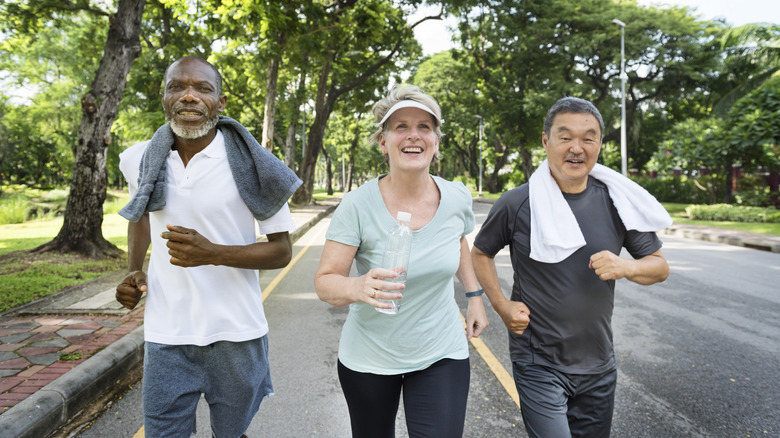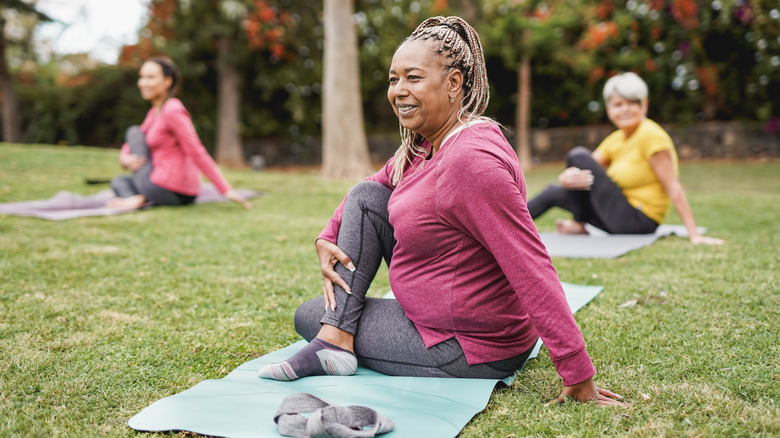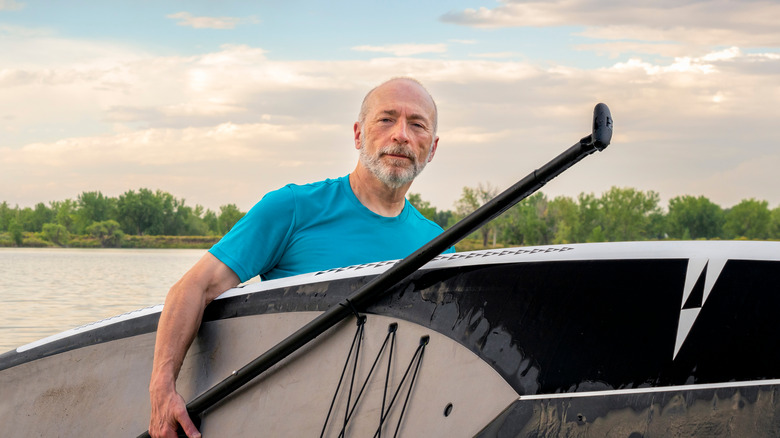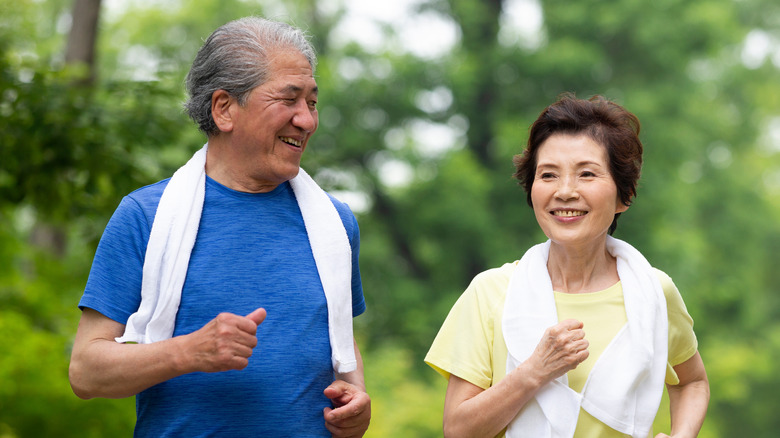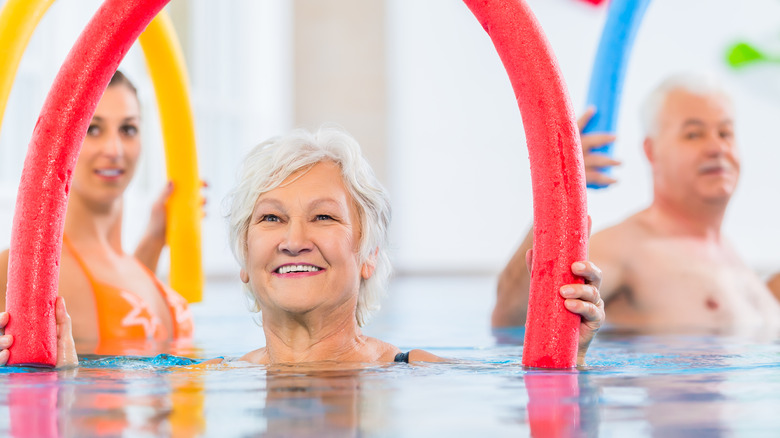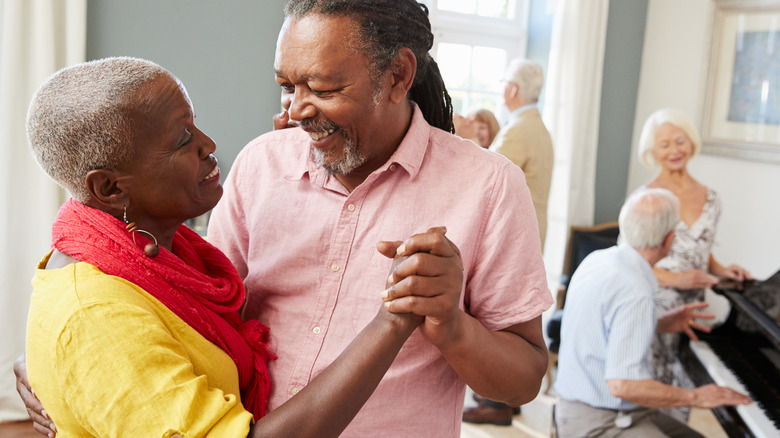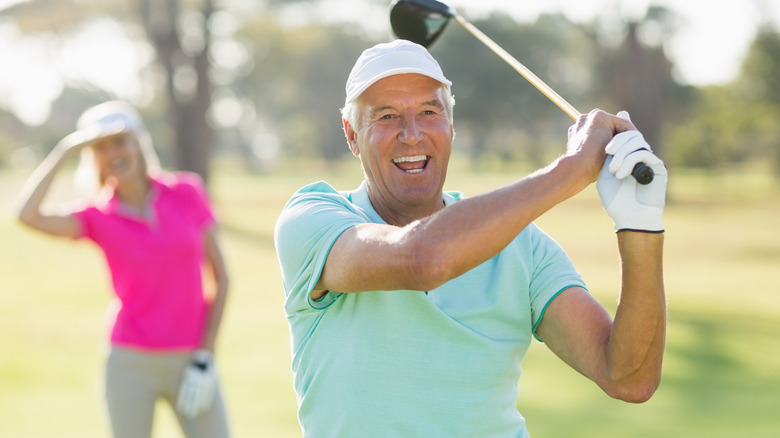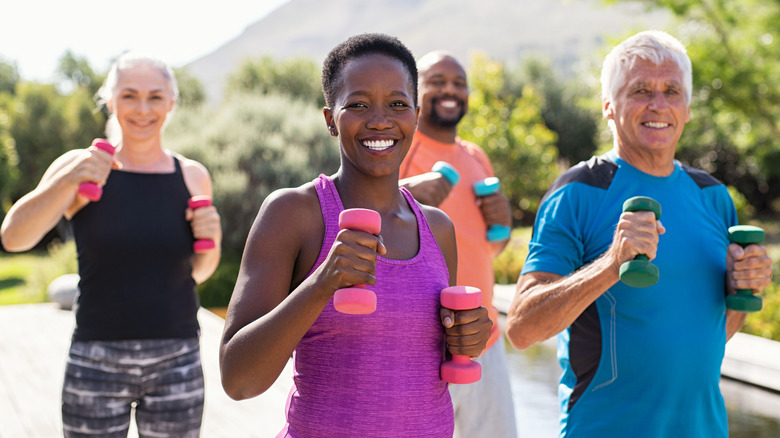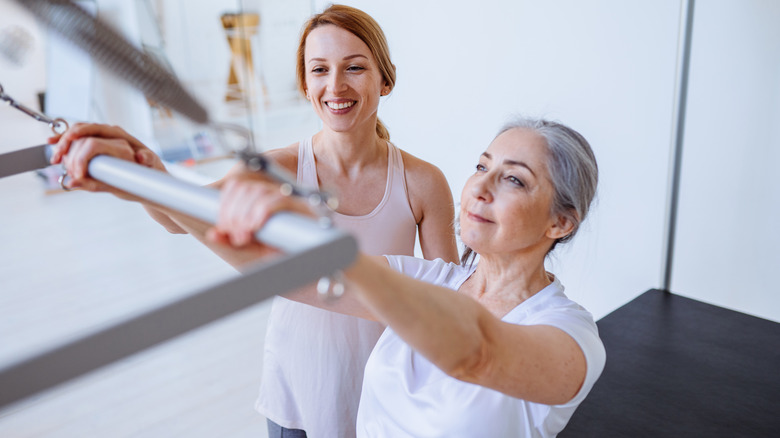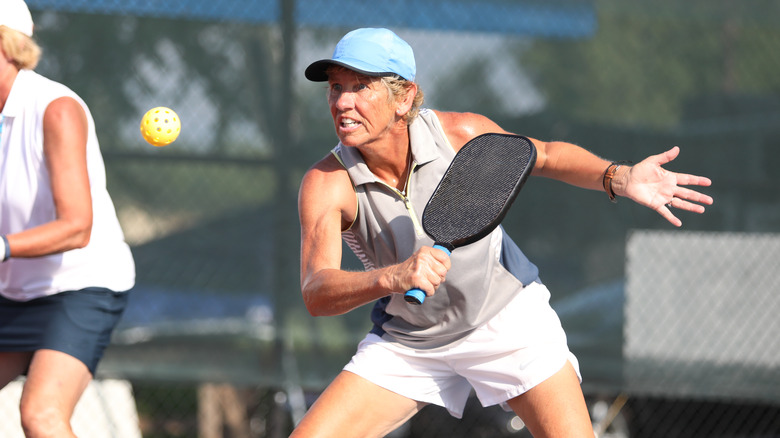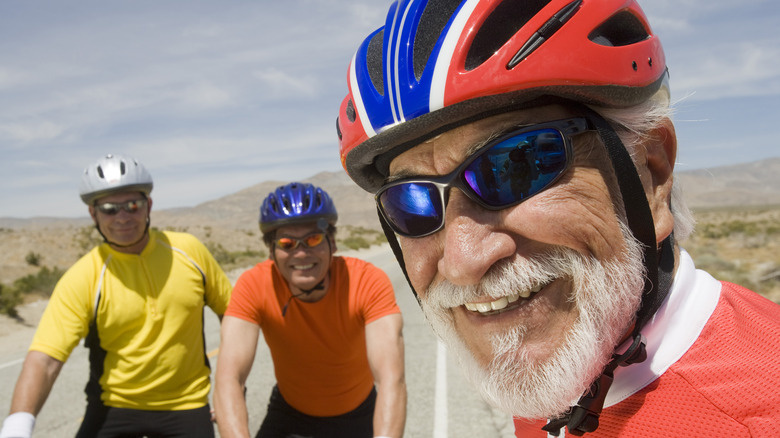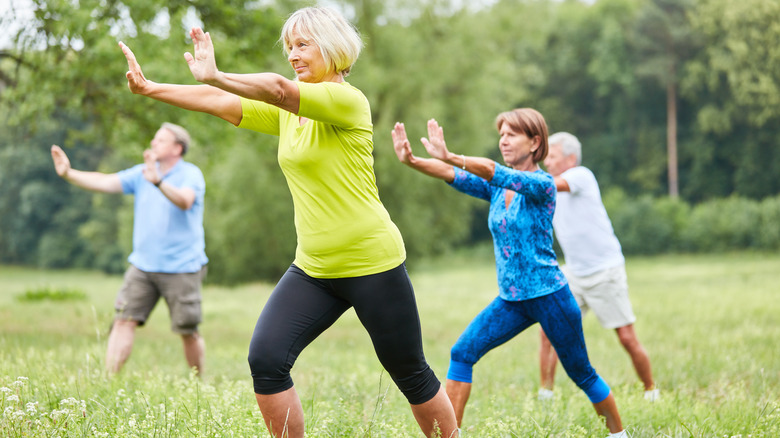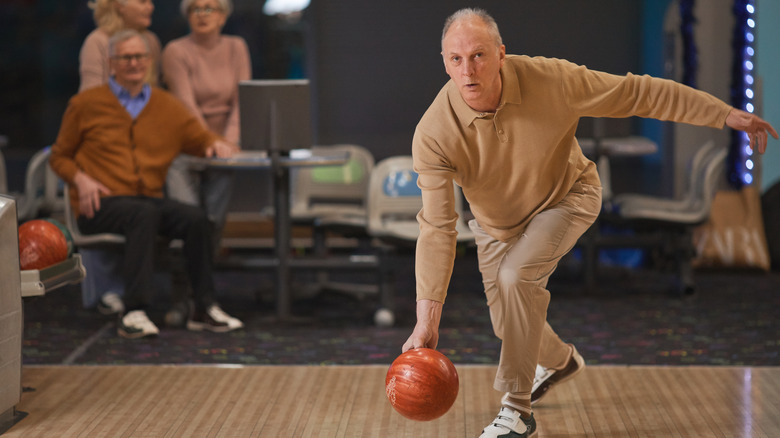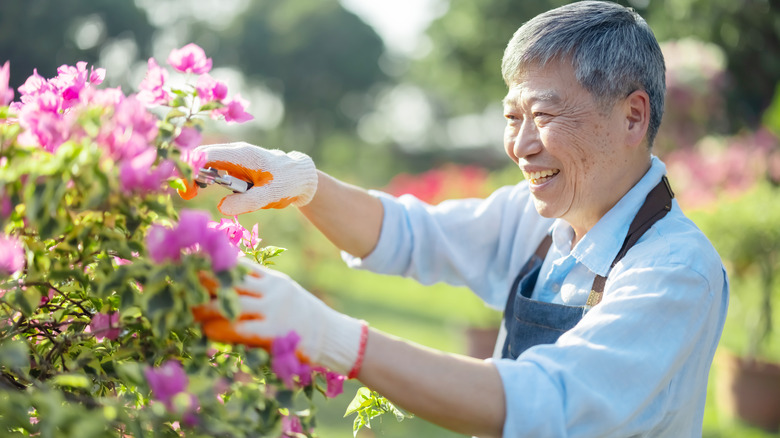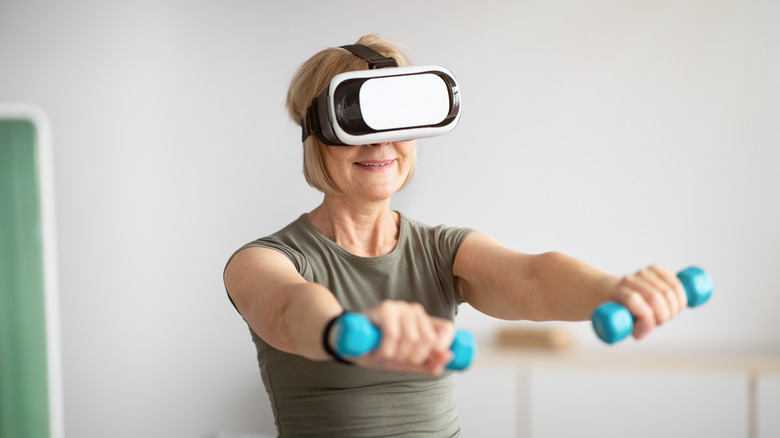The Best Exercises For Older Adults
Loading enough physical activity into your day is important to quality of life. It's one of those things most of us do naturally as kids, but may seem increasing harder to accomplish as we head into our more mature years — a period in our lives starting anywhere between 60 and 73, depending on who you ask (per AARP).
The good news is, you can turn back the clock a little (or a lot) through exercise, keeping many of those common "old age" problems like aching backs, high blood pressure, balance issues, and heart disease at bay. "Exercise is almost like a silver bullet for lots of health problems," says Dr. Alicia I. Arbaje, assistant professor of Geriatrics and Gerontology at Johns Hopkins University School of Medicine (via WebMD). "For many people, exercise can do as much if not more good than the five to 10 medications they take every day".
If you think it's too late for you (it isn't) or are concerned you'll need a gym membership or some pricey specialty equipment (you don't), just read on. We have lots of suggestions for you! "You don't need to be a competitive athlete to reap the benefits," Steve Harridge, a professor of physiology at King's College London, told BBC News. "Anything which gets you moving and a little bit out of puff will help."
Developing flexibility and better health with yoga
Is yoga more than just a means to increased flexibility? The answer is an enthusiastic "Yes!" The National Center for Complementary and Integrative Health (NCIIH) describes yoga as a group of disciplines that promote well-being through physical postures, breathing techniques, and meditation. "As well as yoga being a physical practice, it also includes meditation, taking the time to connect with the body, breath, and mind — having the opportunity to slow down in our busy lifestyles and focus inwards to ourselves," Jill Simpson, founder of Ebb&Flow, told Harper's Bazaar.
Many studies have shown the positive effects of yoga on the body and mind for conditions that widely affect older adults. One review in the Journal of Evidence-Based Integrative Medicine cited a dozen studies showing "significant change in blood pressure using yoga as part of the intervention," while another review cited a series of studies documenting a reduction in low-back pain employing yoga as therapy. "Yoga is a great activity for you if you have diabetes, high blood pressure, high cholesterol, or heart disease. It gives you strength, flexibility, and mind-body awareness," reports WebMD.
Carol Krucoff, a yoga therapist at Duke Integrative Medicine in Durham, N.C. told the Washington Post, "Let go of excuses that you're too old. You don't have to be young or fit or flexible to try yoga. If you can breathe, you can practice yoga."
Paddleboarding for balance and strength
Paddleboarding is a sport that engages virtually your entire body: arms, legs, and core. You'll build strength and balance while enjoying a connection with nature — and unlike surfing, no waves are required! It's a great activity for anyone, including older adults, as you can paddle on a calm body of water and put as much (or as little) effort into it as you like.
It can seem intimidating to get on a paddleboard at first — they're huge! — but the learning curve for beginners is fairly minimal. Adult beginner's boards are quite wide (32 to 34 inches) making them very stable, and by learning proper technique from an instructor (supervised classes are highly recommended) you'll gain confidence and be hooked in no time. You do need equipment — a board, paddle, ankle leash (to keep the board with you if you fall), and a personal flotation device (vest or belt) for water safety — but they can all be rented on an hourly basis.
"The reason so many people are drawn to paddleboarding is that it's an amazing full-body workout that improves your core strength, cardio fitness, balance, and flexibility with virtually no impact," Cody White, co-founder of Finger Lakes Paddleboard in upstate New York and a certified PaddleFit instructor, told Men's Journal.
Walking for cardiovascular health and fitness
Keeping your body moving each and every day has big, positive impacts on your health — and putting one foot in front of the other is an excellent way to start. After all, a good-fitting pair of athletic shoes and some comfortable clothing are all you need to get started walking.
Using an activity device like a Fitbit or Apple Watch to track your progress will also help keep count of your daily steps, adding motivation to continue improving your stats and fitness. As it turns out, you may not even need to reach the general target of 10,000 steps a day, according to a 2019 study. It concluded that just 4,400 daily steps was enough to reduce risk of early death by 40% in septuagenarian women — with a maximum benefit only up to 7,500 steps (via New York Times).
As Forbes Health puts it: "Walking is one of the best forms of cardio for older adults and can be modified to match the pace, distance, or time that feels right for the individual."
Easing your way into water aerobics and swimming
The buoyancy of water makes water aerobics and swimming especially kind on the joints — and an ideal low-impact whole-body activity for older adults. "Due to the reduction in body weight and stress it puts on your joints, swimming can offer the opportunity to move in ways that you can't on land owing to the support provided by the water," says Emily Morrissey, a swimming instructor for Swimming Nature in London (via Women's Health).
Water aerobics enjoys the same buoyancy benefits of the water, while also allowing you to get a fun, group cardio workout to music. If you have mobility issues or a fear of falling, water aerobics will put you at ease, says Baptist Health. Most classes are held in the shallower end of a pool, so you don't even need to know how to swim!
"It's clear that aqua aerobics or water-based activities provide significant benefits for older adults, including increasing metabolism," says Wojtek Chodzko-Zajko, Ph.D, head of the department of kinesiology at the University of Illinois at Urbana-Champaign (via WebMD). "It is never too late to introduce physical activity in life."
Heating up the dance floor (and boosting brain health)
Staying active is hard when you think of exercise as work. So why not put on your favorite tunes, shake your hips, raise your hands, and dance your way to fitness? Get your groove on with line dancing, salsa, ballroom, folk dancing, Zumba or Jazzercise, or chair dancing — all are fun, social, and beneficial ways to elevate your heart rate and get a good workout.
Grooving to music boosts brain health, too. One study showed that 63 to 80 year olds participating in weekly 90-minute dancing lessons increased their brain's hippocampal volume, the regions for learning and memory, in just 18 months.
Dancing "stimulates the motor and sensory circuits in the brain. These benefits ... offer older adults a unique brain activation they might not get from the gym," says Heidi Rossetti, Ph.D, a board-certified neuropsychologist at UT Southwestern Medical Center. "Regular physical, mental, and social stimulation is the gold standard recommendation for reducing the risk of dementia. Because it involves all three, dancing can be seen as a 'triple-threat' option for older adults who want to protect their brains."
Gaining core strength on the golf course
Many sports are difficult to continue well into our golden years, but golf is not among them. Of the nearly 25 million Americans who play the game, about 5 million are age 65 and older, per the National Golf Foundation. People in all stages of life love the sport because it's both ageless and fun! You can take up golf as a child or later in life, and play it well into your retirement years.
In a 2020 study by the American Stroke Association, golfing at least once a month lowered risk of premature death among seniors. Lead author and Zeenat Qureshi Stroke Institute executive director Dr. Adnan Qureshi says, "Older adults can continue to play golf, unlike other more strenuous sports ... Additional positive aspects are stress relief and relaxation, which golf appears better suited for than other sports."
In addition to the mental health benefits of being outdoors and the physical benefits from swinging the club, many golfers take it a step further by walking on the course as well. Leaving the ubiquitous cart behind surged in popularity in 2020, as golf was one of the few outdoor activities still allowing pandemic-era play. "People discovered they liked walking and even when COVID rules were lifted ... and carts came back, people were like, 'No, we're going to keep walking,'" Jerramy Hainline, senior vice president of online tee-time service GolfNow, told the New York Times. "Walking is now here to stay."
Building a stronger, healthier body through strength training
Seniors seeking increased energy or weight loss often look to lifting weights, using resistance bands, or taking up a routine of other bodyweight exercises. By adding this type of strength training to your routine, you can increase bone density and range of motion, improve balance, and combat other negative effects of aging.
The results of strength training can be transformative in just weeks. An Australian study demonstrated that women age 65 and older with low bone mass improved their bone strength and function by participating in twice-weekly 30-minute high-intensity resistance exercises over an eight-week supervised period. "We believe HiRIT (high-intensity resistance exercises) to be a highly appealing therapeutic option for the management of osteoporosis in postmenopausal women with low to very low bone mass," the study's authors concluded (via Eat This, Not That!).
Based on CDC estimates, low bone density is a problem for about 48 million American adults over 50 years of age (most of them women), according to the Washington Post. This condition is a precursor of osteoporosis, which is a weakening of the bones, and can lead to sudden fractures. Along with building healthier and stronger bodies, the Cleveland Clinic agrees that strength training and staying physically active will help older adults preserve their independence and vitality.
Improving posture and reducing chronic back pain with Pilates
As a low-impact form of exercise that can provide pain relief for many chronic muscular issues, Pilates offers an ideal exercise program for seniors. Not only does it work on improving bone density and lessen fracture risk, it may also improve posture, balance, and mobility by focusing on the body's core muscles.
You may be wondering how Pilates is different from yoga. The two share some similarities, such as being low impact and incorporating mat exercises. However, Pilates focuses more on precise muscle strengthening exercises and also often uses a specialized machine called a reformer, an apparatus with a sliding bed-like platform that has springs and pulleys for resistance (per Livestrong).
"Pilates is a series of targeted movements and adaptable solutions when injury or chronic pain impairs movement and performance," explains Jill Simpson, founder of Ebb&Flow, a yoga, Pilates, ballet and barre studio in the U.K. The exercise is centered around core strength, but with the "added benefits of muscle toning, overall strength, body control, and flexibility," she told Harper's Bazaar.
Picking up a pickleball routine
You've heard of baseball, football, and handball, but what the heck is pickleball? If you're looking for a racket sport but need less wear and tear on your joints, a game of pickleball may be just the thing for you!
Over 4 million Americans play pickleball (per the USA Pickleball Association), and the sport is wildly popular among seniors. 60% of pickleball's core players are 55 and older, and play more than eight games a year. The sport's popularity is even changing the way new subdivisions are designed. "That demographic is also demanding pickleball courts as part of senior living communities," Kolter Homes vice president of marketing John Manrique told Senior Housing News.
The unusual name comes from rowing, where the "slowest craft is the 'pickle boat'," according to MUSC Health. Pickleball is played in a badminton-sized court — smaller than a tennis court — so there's less running and wear on the joints. The paddle is smaller than a tennis racket but twice the size of a ping-pong paddle, and the ball is different too. It's light, plastic and perforated, similar to a "whiffle ball," which slows down play and makes it easier to hit than a tennis ball.
As a beginner-friendly, competitive, and fun sport, the health advantages of pickleball for seniors are numerous. A 2019 study over a six-week period showed regular pickleball play for middle-aged and older adults improves cholesterol, blood pressure, and cardiorespiratory fitness levels.
Cycling your way to optimum health
Seniors who ride a bicycle as part of their regular routine can also "walk more efficiently" than those who just do leisurely strolls through a neighborhood, says a study published in the Journal of Aging and Physical Activity (via the New York Times). Unlike running (which also aids in improved walking ability for older adults), pedaling your bike is just as beneficial, but with "less mechanical joint loads and risk of orthopedic injury," according to the study.
Improving your immune system to lessen the risk of chronic diseases is another great reason for seniors to jump into cycling. A study in the journal Aging Cell showed that active cyclists age 55 to 79 were producing T-cells at the same rate as those in their 20s who did not regularly exercise (per Time). T-cells are an essential part of the immune system that helps fight infections.
"The immune system declines by about 2-3% a year from our 20s, which is why older people are more susceptible to infections, conditions like rheumatoid arthritis and, potentially, cancer," says Janet Lord, director of the Institute of Inflammation and Aging at the University of Birmingham, U.K., who co-authored research involving long-distance older cyclists. "Because the cyclists have the immune system of a 20-year-old rather than a 70- or 80-year-old, it means they have added protection against all these issues," she told BBC News.
Reducing stress and increasing stamina with tai chi
Tai chi is an ancient form of martial arts originating in China (via Mayo Clinic). Yang-style tai chi dates back to the 19th century and is the most widely practiced style today. Characterized by slow, flowing, sequential movements, tai chi is noncompetitive and low-impact, promoting well-being, increased stamina, and improved balance. It also needs no special equipment and can be done anywhere, alone or in a group.
"Tai chi's movements require you to focus on breathing and movement together. It's like meditation in motion," explains Tim Sobo, licensed acupuncturist at the Cleveland Clinic. "You're focused on what you're doing rather than on everything else going on in your life. The practice of being mindful is a great stress reliever."
Multiple studies have touted tai chi's health benefits, including a 2014 study of more than 2,500 adults age 60 and older that indicated the practice promoted enhanced cognitive function. Hui Hwang, licensed acupuncturist at UCI Health, sums up the benefits this way: "By practicing [the] movements, one can feel the elimination of burdens and a distance from external stressors, bringing us simplicity, sensitivity, and connecting our senses to our internal mind and body" (via Susan Samueli Integrative Health Institute).
Bowling for muscle strength and flexibility
You might not think of bowling as a form of exercise, but when you do the math, it's clear that all the lifting and walking add up to a lot of activity!
Consider this: A bowling ball weighs about 12-14 pounds, and every time you step up for your turn — about 22 times per game — you're repeatedly lifting that weight, says HCP Live. Well, hello! That's a strength training exercise. Also, the steps you take walking from your chair to the foul line and back, or about 71 steps per minute? Well, that's up to 1,065 steps a game per 15 minutes of typical play.
Bowling is a popular pastime for seniors, says the The Patriot-News, as it offers competition, camaraderie, and a fun way to stay active. The exercise received from bowling is almost like a bonus. The game involves lifting, swinging, bending, and twisting the body, all of which strengthens your core, improves muscle tone and flexibility, and can even aid in weight loss (per Arizona Republic).
"The best exercise plan is not just one you feel comfortable doing, but one you enjoy and are likely to do regularly," says Forbes Health.
Improving body and mind by gardening
Digging, raking, trimming, and lifting — oh yes, anyone who's done any heavy gardening knows it is as physically demanding as it is rewarding.
The Centers for Disease Control and Prevention (CDC) classifies gardening as a moderately intense exercise, so it makes the cut as a worthy activity to add to your fitness routine. Activities in this category can reduce risk for obesity, high blood pressure, stroke, depression, and so much more by doing them just 30 minutes a day, five times a week. A field experiment published in the Journal of Health Psychology concluded that gardening can even "promote relief from acute stress."
Not only is gardening physically active, but you're connected with nature — and that's been shown to reduce depression, reports The Guardian. In fact, planting herbs and vegetables are especially rewarding for mental health and clarity, according to Michigan State University. "Food gardening can particularly be gratifying and an excellent source of fresh produce. From soil preparation to the joy of harvesting, there is always a task, big or small, during the growing season!"
Exercising in virtual reality for real-life results
Virtual reality (VR) exercise and fitness video games have been popular for a while, but they've taken on an even greater life since the start of the COVID-19 pandemic as an easy way to stay fit at home. It's fun working up a sweat while immersed in a simulated three-dimensional scene, Men's Journal states, or plugging into a gaming console to play tennis, bowling, or golf using motion controllers that detect your every move. All these dips into a virtual world are not just for the young, but also for seniors looking to stay active (and have a good time doing it).
"Across studies, findings demonstrate that VR exercise interventions lead to significant improvements in older adults' balance and memory, which contribute to a lower risk for falls," declares a 2020 article in the Journal of Clinical Medicine.
As VR Fitness Insider reports, one of virtual reality's main assets for older users "is that it encourages aerobic activity, balance training, and muscle-strengthening exercises." For users who are tech-savvy or have someone who can help them get set up, VR may be the perfect tool for starting a home-based healthy fitness routine.

